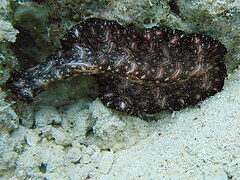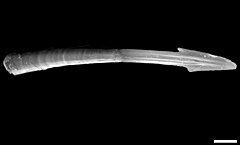List of bilateral animal orders contains the Bilateria of the animal subkingdom Eumetazoa, divided into four superphyla, Deuterostomia, and the three Protostome superphyla, Ecdysozoa, and the two Spiralia superphyla, Platyzoa and Lophotrochozoa.






Phylum Xenacoelomorpha edit
- Subphylum Xenoturbelida
- Class incertae sedis (Family Xenoturbellidae)
- Subphylum Acoelomorpha
- Class Acoela
- Order incertae sedis (16 families)
- Class Nemertodermatida
- Order incertae sedis (2 families)
Nephrozoa (unranked) edit
Superphylum Deuterostomia edit
Phylum Chordata edit
Ambulacraria edit
Phylum Hemichordata edit
- Class Enteropneusta (Acorn worms)
- Order Enteropneusta
- Class Graptolithina †
- Order Camaroidea †
- Order Crustoidea †
- Order Dendroidea †
- Order Dithecoidea †
- Order Graptoloidea †
- Order Stolonoidea †
- Order Tuboidea †
- Class Planctosphaeroidea
No order, one genus, one species Planctosphaera pelagica
- Class Pterobranchia
- Order Cephalodiscida
- Order Rhabdopleurida
Phylum Echinodermata edit
Infrakingdom Protostomia edit
Superphylum Ecdysozoa edit
Cycloneuralia (unranked) edit
Scalidophora (unranked) edit
Phylum Kinorhyncha edit
No class, 2 orders, called mud dragons, very common in mud or sand
- Order Cyclorhagida
- Order Homalorhagida
Phylum Loricifera edit
No class, one order Nanaloricida
Phylum Priapulida edit
- Class Priapulimorpha
- Order Priapulimorphida
- Family Priapulidae
- Family Tubiluchidae
- Class Halicryptomorpha
- Order Halicryptomorphida
- Class Seticoronaria
- Order Seticoronarida
- Genus Maccabeus
Nematoida (unranked) edit
Phylum Nematoda edit
Phylum Nematomorpha edit
- Class Gordioidea
- Class Nectonematoida
Panarthropoda (unranked) edit
Phylum Lobopodia † edit
- Class Xenusia
- Order Archonychophora
- Order Protonychophora
- Aysheaiidae
- Xenusiidae
- Order Archonychophora
- Order Scleronychophora
- Order Paronychophora
- Order unassigned
Phylum Onychophora edit
No classes, no orders, families Peripatidae and Peripatopsidae
Tactopoda (unranked) edit
Phylum Tardigrada edit
- Class Eutardigrada
- Order Apochela
- Family Milnesiidae
- Order Parachela
- Family Beornidae
- Family Calohypsibiidae
- Family Eohypsibiidae
- Family Hypsibiidae
- Family Macrobiotidae
- Family Microhypsibiidae
- Family Necopinatidae
- Class Heterotardigrada
- Order Arthrotardigrada
- Family Archechiniscidae
- Family Batillipedidae
- Family Coronarctidae
- Family Halechiniscidae
- Family Renaudarctidae
- Family Stygarctidae
- Order Echiniscoidea
- Family Echiniscidae
- Family Echiniscoididae
- Family Oreellidae
Phylum Arthropoda edit
Spiralia (unranked) edit
Gnathifera (unranked) edit
Phylum Gnathostomulida edit
No classes
- Order Bursovaginoidea
- Order Filospermoidea
Phylum Micrognathozoa edit
Some dispute here with Micrognathozoa as the class and Limnognathia as the order
Phylum Cycliophora edit
- Class Eucycliophora
- Order Symbiida
- Family Symbiidae
- Genus Symbion
- Family Symbiidae
Syndermata (unranked) edit
Phylum Rotifera edit
- Class Bdelloidea
- Order Bdelloida
- Class Monogononta
- Order Collothecida
- Order Flosculariida
- Order Ploimida
- Class Seisonidea
- Order Seisonida
Phylum Acanthocephala edit
- Class Archiacanthocephala
- Order Apororhynchida
- Order Gigantorhynchida
- Order Moniliformida
- Order Oligacanthorhynchida
- Class Eoacanthocephala
- Order Gyracanthocephala
- Order Neoechinorhynchida
- Class Palaeacanthocephala
- Order Echinorhynchida
- Order Polymorphida
Platytrochozoa (unranked) edit
Mesozoa (unranked) edit
Phylum Dicyemida edit
No classes, no orders, families Conocyemidae, Dicyemidae and Kantharellidae
Phylum Monoblastozoa edit
No classes, no orders, family Salinellidae
Phylum Orthonectida edit
No classes, no orders, families Pelmatosphaeridae and Rhopaluridae
Rouphozoa (unranked) edit
Phylum Platyhelminthes edit
- Class Rhabditophora
- Subclass Macrostomorpha
- Order Dolichomicrostomida
- Subclass Trepaxonemata
- Infraclass Neoophora
- Parvclass Eulecithophora
- Superorder Adiaphanida
- Order Fecampiida
- Order Prolecithophora
- Order Tricladida
- Order Rhabdocoela
- Superorder Adiaphanida
- Order Bothrioplanida
- Order Lecithoepitheliata
- Order Proseriata
- Parvclass Eulecithophora
- Order Gnosonosemida
- Order Polycladida
- Order Prorhynchida
- Infraclass Neoophora
- Subphylum Neodermata
- Class Cestoda
- Subclass Eucestoda
- Order Bothriocephalidea
- Order Caryophyllidea
- Order Cathetocephalidea
- Order Cyclophyllidea
- Order Diphyllidea
- Order Diphyllobothriidea
- Order Haplobothriidea
- Order Lecanicephalidea
- Order Litobothriidea
- Order Nippotaeniidea
- Order Onchoproteocephalidea
- Order Phyllobothriidea
- Order Proteocephalidea
- Order Pseudophyllidea
- Order Rhinebothriidea
- Order Spathebothriidea
- Order Tetrabothriidea
- Order Tetraphyllidea
- Order Trypanorhyncha
- Class Monogenea
- Subclass Monopisthocotylea
- Order Capsalidea
- Order Dactylogyridea
- Order Gyrodactylidea
- Order Monocotylidea
- Order Montchadskyellidea
- Subclass Polyopisthocotylea
- Order Chimaericolidea
- Order Diclybothriidea
- Order Mazocraeidea
- Order Polystomatidea
- Class Trematoda
- Subclass Aspidogastrea
- Order Aspidogastrida
- Order Stichocotylida
- Subclass Digenea
- Order Diplostomida
- Order Plagiorchiida
Phylum Gastrotricha edit
No classes
- Order Chaetonotida
- Order Macrodasyida
Superphylum Lophotrochozoa edit
Phylum Mollusca edit
Phylum Annelida edit
Kryptotrochozoa (unranked) edit
- Phylum Nemertea
- Class Anopla
- Order Heteronemertea
- Order Palaeonemertea
- Class Enopla
- Order Bdellonemertea
- Order Hoplonemertea
- Lophophorata (unranked)
- Brachiozoa (unranked)
- Phylum Hyolitha †
- Order Hyolithida
- Order Orthothecida
- Phylum Brachiopoda
- Class Lingulata
- Class Craniata/Craniforma
- Order Craniida
- Class Rhynchonellata
- Order Terebratulida
- Order Rhynchonellida
- Phylum Phoronida
- Phylum Hyolitha †
No classes, no orders, family Phoronidae
- Bryozoa (unranked)
- Phylum Ectoprocta
- Class Gymnolaemata
- Order Cheilostomata
- Order Ctenostomatida
- Class Phylactolaemata
- Order Plumatellida
- Class Stenolaemata
- Order Cryptostomata †
- Order Cryptostomida †
- Order Cyclostomatida
- Order Cystoporida †
- Order Cystoporida †
- Order Esthonioporata †
- Order Fenestrida †
- Order Hederellida †
- Order Melicerititida †
- Order Rhabdomesida †
- Order Trepostomatida †
- Class Gymnolaemata
- Phylum Entoprocta
- Phylum Ectoprocta
No classes, no orders, families Barentsiidae, Loxokalypodidae, Loxosomatidae and Pedicellinidae
References edit
- ^ Amin, O. A; Heckmann, R. A; Ha, N. V. (2014). "Acanthocephalans from fishes and amphibians in Vietnam, with descriptions of five new species. '". Parasite. 21: 53. doi:10.1051/parasite/2014052. PMC 4204126. PMID 25331738.